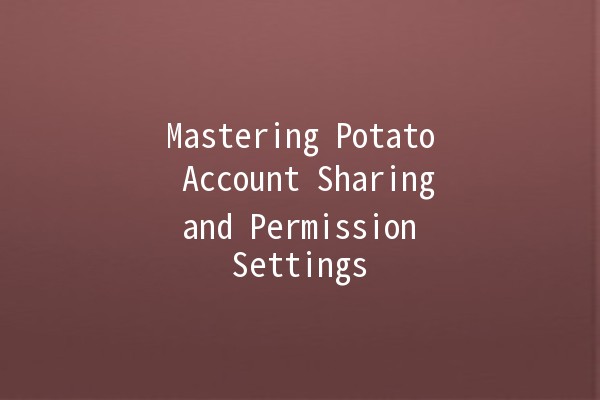In today’s digital world, account sharing and permission management have become essential facets of managing online resources efficiently and securely. Whether it's for collaboration among team members or sharing resources with friends and family, understanding how to effectively share your Potato account while maintaining the necessary permissions is crucial. This article will delve into practical tips and strategies for optimizing your Potato account sharing, ensuring you maximize productivity without compromising security.
Understanding Potato Account Sharing
Before we get into the techniques, let’s clarify what Potato account sharing entails. Potato accounts are commonly used in various online services, ranging from cloud storage to streaming services. Sharing your Potato account involves allowing other users to access your account under specific permission settings. Proper management of these settings ensures that users can collaborate efficiently without exposing sensitive information.
Importance of Permission Settings
Permission settings play a pivotal role in account sharing as they dictate the level of access each user has. Mismanaging permissions can lead to data breaches, unauthorized access, or simply an ineffective collaboration experience. Therefore, understanding how to configure these settings is essential for anyone who shares their Potato account.

Productivity Enhancement Techniques
Explanation
When sharing your Potato account, it’s vital to define clear roles for each user. This involves outlining who is responsible for what and ensuring everyone knows their specific duties within the shared environment.
Practical Application
Consider a scenario where you are sharing a Potato account with three teammates for a project. Assign roles such as "Project Manager," "Content Creator," "Research Analyst," and clearly communicate their responsibilities. For example:
Project Manager: Oversees project timelines and deliverables.
Content Creator: Responsible for developing written and visual content.
Research Analyst: Conducts research and compiles data.
Clear roles eliminate confusion and streamline collaboration, leading to increased productivity.
Explanation
Potato accounts typically offer various permission levels, such as Admin, Editor, and Viewer. Understanding these levels and utilizing them wisely can significantly enhance how your account is used.
Practical Application
If you are working on a document with sensitive information:
Admin: Grant this role to someone who needs full control (e.g., for making significant edits or changes).
Editor: Assign editors to users who need permission to modify content but not to change settings.
Viewer: Use this level for individuals who only need to read the content without editing capabilities.
By assigning appropriate permission levels, you minimize the risk of unauthorized changes while ensuring that everyone involved can contribute effectively.
Explanation
Over time, the needs of your shared account may change, making it essential to regularly review user permissions to align with current requirements.
Practical Application
Set a recurring schedule (monthly or quarterly) to assess user access:
Remove Inactive Users: If a user has not engaged with the account for an extended period, consider revoking their access.
Adjust Permissions Based on Activity: If a person moves from the research phase to content creation, update their permission level accordingly.
This habit ensures only the necessary individuals have access to your Potato account and enhances overall security.
Explanation
Communication is crucial when modifying permissions or accountsharing protocols. All users should be informed of any changes that might impact their access rights.
Practical Application
Utilize tools like Slack or email notifications to inform users of:
New roles being assigned.
Changes in permission levels.
Any security protocols being implemented.
For instance, if you decide to upgrade someone’s access from Viewer to Editor due to their increased involvement in the project, notify the team to ensure everyone is on the same page.
Explanation
Adding an extra layer of security like TwoFactor Authentication can protect your Potato account from unauthorized access, especially when shared among multiple users.
Practical Application
Encourage all users with access to enable 2FA on their accounts:
This could involve using a mobile app like Google Authenticator or receiving SMS codes.
Inform users of the 2FA implementation process and its importance in safeguarding the account.
With 2FA enabled, even if someone obtains a password, they would still need a second form of verification to access the account.
Common Questions About Potato Account Sharing and Permission Settings
To share your Potato account safely, always utilize the permission settings to control access levels diligently. Assign roles based on individual needs, monitor activities regularly, and implement security measures such as 2FA.
Yes, permissions can typically be adjusted at any time. Regular reviews of user roles and responsibilities allow for these changes to be made as necessary, ensuring that your account's security and functionality remain intact.
Most platforms offer activity logs or reports that detail user actions. Regularly reviewing these logs allows you to stay informed about who accessed what and any changes made, enhancing accountability.
If you suspect misuse, immediately review the access levels you have assigned and adjust them as required. Consider changing your password and enabling 2FA for added security.
Yes, you can revoke a user's access at any time through your account settings. This action will prevent them from gaining future access to your Potato account.
Set up a communication protocol, such as a weekly or monthly update email, where you outline any changes in permissions, roles, or responsibilities. This keeps everyone in the loop and minimizes confusion.
By following these techniques and understanding how to manage permissions, you can create a safe and efficient environment for sharing your Potato account. Leveraging these strategies not only enhances productivity but also reinforces security, ensuring that your information remains protected while enabling collaborative work.